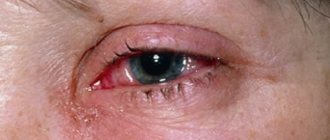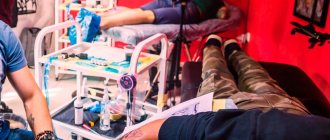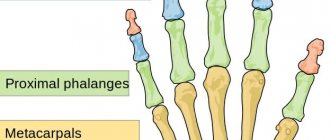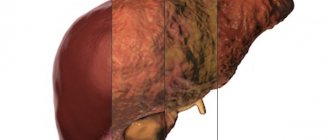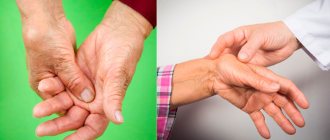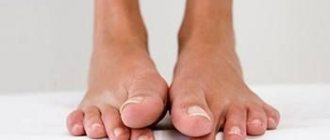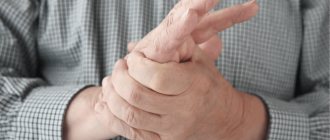Surgeon
Bohyan
Tigran Surenovich
Experience 36 years
Surgeon of the highest category, Doctor of Medical Sciences, member of the International Association of Surgeons, Gastroenterologists and Oncologists
Make an appointment
Panaritium is an acute purulent inflammatory process that is localized in the tissues of the fingers or toes, as well as on the palmar surface of the palms.
Panaritium on the finger is manifested by swelling and redness, pain and elevated body temperature, as well as other symptoms of general intoxication.
Diagnosis of panaritium is carried out taking into account the patient’s complaints and examination by a specialist. In cases of suspected deep forms (bone/articular) pathology, an x-ray is prescribed. The initial stage of the disease can be treated with conservative methods; in later stages, an abscess forms, which requires drainage and opening, and in advanced cases, amputation is performed.
Panaritium mainly occurs on the hands; panaritium is extremely rare on the legs. Belongs to the category of pathologies of purulent surgery. The development of pathology occurs with the participation of pyogenic microorganisms that penetrate the tissue through the slightest defects and cracks in the skin. The most common microorganism is staphylococcus.
The mild stage of felon on the arm or other part of the body is characterized by swelling, pain and redness. The severe stage is accompanied by chills and high fever. Painful sensations are characterized by sharpness and pulsation, often leading to insomnia.
Symptoms
The form of the disease directly affects the symptoms of felon, and there are a number of similar symptoms. The initial stage is mild swelling and mild pain.
All subsequent stages are intensification and increase in pain, swelling, redness, burning. In this case, the pain sensations are characterized as bursting and tugging, strong in intensity.
A distinctive feature of any form of pathology is the presence of a purulent focus, during the formation of which the patient feels symptoms of intoxication - weakness, increased fatigue, high temperature, headaches. At the same time, deeper forms of the disease have more pronounced signs of intoxication.
Characteristic features of various types of panaritium:
- cutaneous or panaritium of the nail and the area of the nail phalanx - redness, peeling of the skin at the site of redness, formation of a bubble with turbid liquid, mild increasing pain, pulsation, stem lymphangitis or the presence of a red stripe from the hand to the forearm in the locations of the lymph nodes;
- periungual or paronychia appears as a panaritium on the finger after an unsuccessful manicure and nail treatment, as well as during heavy physical labor - slight swelling, redness, rapid filling of the entire nail and the formation of an abscess, pain at the site of the outbreak;
- subungual panaritium or a complication of periungual panaritium, panaritium appears independently on the thumb as a result of puncture wounds or splinters - severe pain, rapid formation of an abscess, severe swelling, general malaise and high fever;
- subcutaneous panaritium when deep puncture wounds are infected - redness and local pain become intense after a few hours, swelling is large, suppuration is accompanied by chills and high fever;
- bone panaritium when an open bone fracture is infected or when infection spreads from a subcutaneous type of panaritium - bone destruction with severe pain, flask-shaped appearance of the affected limb, smooth and shiny skin, chills and fever;
- articular develops when infected through open fractures or is a complication from the tendon, subcutaneous and bone type - pain when moving the joint and mild swelling turn into the inability to move the joint due to pain and swelling, eventually a fistula is formed;
- tendon panaritium on the toe or purulent tendovaginitis - uniform swelling, externally bent finger, intense increase in pain during movements, lack of appetite, weakness, high temperature, delirium and confusion. The most dangerous type of pathology due to the speed of spread of pus into neighboring tissues.
Are you experiencing symptoms of panaritium?
Only a doctor can accurately diagnose the disease. Don't delay your consultation - call
Causes
Panaritium is a bacterially caused nonspecific inflammation. Most often, pyogenic staphylococci and streptococci are the causative agents. But the participation of other pathogenic microorganisms (for example, yeast-like fungi) and mixed infections cannot be ruled out. Sometimes the herpetic form of the disease also occurs.
The route of penetration of pathogens is exclusively exogenous. In most cases, the entry points are minor skin lesions. Therefore, patients with panaritium may have a history of injections with sewing needles and plant thorns, cuts (including when cutting nails), wounds after torn hangnails, removed or remaining splinters, and abrasions.
An increased risk of developing felon is observed in people whose work activities or hobbies involve processing wood, metal and other surfaces. Fishermen and workers in fish processing plants are prone to this disease. Less commonly, infection occurs through animal bites, lacerations and crushed wounds, and open fractures of the fingers.
The development of felon is promoted by:
- incorrect or untimely treatment of injuries received;
- using tools that have not been cleaned for a long time for manicure;
- excessive cutting of the edges of the nail plates;
- wearing tight, poorly ventilated shoes;
- repeated long-term macerations of the skin;
- the presence of diabetes mellitus, polyhypovitaminosis and immunodeficiency conditions of any origin;
- chronic microcirculation disorders in the fingers caused by vibration, repeated hypothermia, exposure to toxic compounds (metals, mineral oils, quicklime).
In most cases, the disease is caused by injuries at work and existing occupational predisposing hazards. Domestic reasons account for 10-15%.
Routes of infection and risk factors
The risk group for developing the disease includes:
- children;
- age category from 20 to 50 years - working in production.
The most common places where pathology appears are the 1st, 2nd and 3rd fingers of the right hand.
External factors in the development of pathology:
- hydration,
- vibration,
- maceration,
- systematic cooling,
- action of irritants,
- pollution.
Internal factors in the development of the disease:
- endocrine diseases and disruptions;
- weakened immunity;
- lack of vitamins;
- impaired metabolism.
General information
Panaritium (lat. Panaricium; popular - hair/hair), is an acute purulent inflammation of the tissues of the finger or toe.
In the modern understanding, the term “felon” does not mean any particular nosological form, but a whole group of acute/chronic inflammatory diseases that develop in various anatomical structures of the finger. Panaritium on the finger is one of the most common in the practice of treating purulent pathologies of the hand, and the proportion of panaritium in the structure of all purulent-inflammatory diseases of the hand is about 40%. ICD-10 felon code: L03.0. Phlegmon of the fingers and toes. The features and development of the course of felon, in contrast to purulent diseases of the hand in other localizations, are largely determined by the peculiarities of the anatomy of the finger. The presence of a large number of important anatomical formations located over a relatively small area: interphalangeal joints , fibrous sheaths , synovial membranes , tendons , cellularity of the subcutaneous tissue , penetrated by fibrous bridges, an abundance of blood-lymphatic vessels, as well as nerve endings, contribute to the extremely rapid spread of purulent-inflammatory local process.
In most cases, the inflammatory-purulent process is localized on the index/middle finger of the right hand, and on the foot - the big toe is affected. Below is a photo of a panaritium of a finger and a toe.
Infection occurs mainly due to various microtraumas of the fingers, both at home and at work, and failure to comply with sanitation rules when treating minor abrasions, “burrs,” “splinters,” etc.
The development of felon on a finger or toe is one of the common causes of patient disability, and late contact with a doctor/inadequate treatment of felon is accompanied by the risk of generalization of the inflammatory process.
Classification
Classification of panaritium is carried out according to the location and nature of tissue damage:
- cutaneous - mild form, an abscess in the thickness of the epidermis;
- periungual - an abscess near the nail fold;
- subungual - an abscess under the nail plate;
- subcutaneous - on the surface of the palm;
- bone – accompanied by bone rotting;
- articular – interphalangeal joints and metacarpophalangeal joints;
- osteoarticular – a progressive form of articular, affects the joint and bones of the phalanges;
- tendinous - the most dangerous, affects the tendons.
Laundry soap
For the bath you need to prepare regular laundry soap and hot water.
- Grate the soap and dissolve a tablespoon of soap shavings in boiling water;
- The solution is cooled to a temperature of 60-70 degrees and the sore finger is dipped into it;
- Make the bath for at least 20 minutes, constantly adding hot water.
It is necessary to take soap baths at least 4 times a day. After the procedure, the finger is dried with a towel, and then Vishnevsky ointment or Levomekol is generously applied.
When to see a doctor
Treatment of panaritium is carried out by a surgeon, traumatologist, and osteopath. If you suspect purulent inflammation, you should contact a surgeon. He will make an accurate diagnosis and tell you how to treat panaritium.
You can make an appointment with any of the specialists listed above at JSC “Medicine” (clinic of Academician Roitberg) in the center of Moscow near the Mayakovskaya, Belorusskaya, Novoslobodskaya metro stations.
Pathogenesis
The stages of development of acute panaritium correspond to the stages of classic purulent inflammation. After the penetration of a pathogenic agent and its subsequent reproduction, a reaction of adjacent tissues to it is observed, manifested by impaired microcirculation, edema and migration of immune system cells to the site of inflammation with the production of various inflammatory mediators. The accumulation of a mass of dead microbial and immune cells and exudate against the background of the continued activity of pathogenic microorganisms contributes to the rapid transition of the catarrhal inflammatory process into a purulent one. The phase of serous impregnation of tissues is usually short and is immediately replaced by a phase of purulent-necrotic inflammatory process, since the accumulation of exudate in confined spaces of the fascia in a short time leads to impaired blood circulation of tissues, necrosis and purulent melting.
The anatomical features of the structure of the subcutaneous tissue of the fingers contribute to the spread of the pathological process mainly in depth, which determines the severity of the pain syndrome during a local purulent-inflammatory process.
Subsequent purulent-necrotic melting of connective tissue strands contributes to the transition of the pathological process to tendons, their sheaths, joints and bone, which is accompanied by a rapidly occurring horizontal spread of purulent inflammation. In the absence of timely treatment, there is a high risk of felon turning into phlegmon of the hand , and in the presence of aggravating factors (low immune reactivity of the body, refusal of treatment/late consultation with a doctor) - the development of a general septic condition.
Diagnostics
Only after accurately determining the type and shape, the doctor decides how to cure panaritium. Therefore, it is important to get tested promptly. Diagnosis begins with the collection of complaints and symptoms of the pathology. The form of the disease is determined by palpating the location of the abscess with a button probe.
X-rays are performed to identify lesions of bones and joints. In this case, for the articular form of the disease, x-rays are taken on the same fingers of both hands (both healthy and affected).
At JSC “Medicine” (academician Roitberg’s clinic) you can undergo any diagnostic test with high accuracy of results.
Panaritium in children
Panaritium in a child is a fairly common occurrence, which is due to frequent injuries to a finger on the hand, resulting mainly from cuts, injections, pinching of the distal phalanges by drawers/doors, injections, as well as the imperfection of the child’s immune system. It occurs in children of all ages, including newborns. Clinical manifestations are similar to the symptoms of felon in adults, however, the general condition of the child suffers significantly, which is manifested by fever and high temperature. The principles of diagnosis/treatment are similar.
Treatment
Treatment of the disease of the superficial form is carried out on an outpatient basis, and for deep forms - in a purulent surgery hospital.
Early stages of the disease require conservative treatment - darsonval, thermal procedures and UHF, baths, application of compresses and medicinal ointments, antibacterial and antifungal drugs. If there is no positive dynamics within a week, then surgery is prescribed.
Advanced stages of superficial forms and all deep forms of pathology require surgical intervention. Operation on felon involves opening and drainage for complete outflow of purulent contents.
The tactics of surgical intervention for bone and joint forms is guided by the degree of preservation of the affected tissues. Partial destruction involves removal of the panaritium and damaged areas of tissue, and total spread involves amputation. In this case, antibacterial, analgesic and antitoxic therapy is carried out.
General principles of treatment of the disease:
- complete pain relief;
- complete bleeding during the operation;
- complete removal of pus and affected tissues;
- adequate management of the postoperative period;
- a surgical option that combines functional and cosmetic principles.
Forecast
With adequate/timely treatment, primary articular felons result in complete recovery with preservation of the functions of the affected finger. With inadequate/untimely treatment, the prognosis is less favorable, especially with secondary felons (with the spread of suppuration from neighboring tissues) in the form of the formation of deformities of the phalanges / fingers , ankylosis with disruption of their functions, and in some cases, amputation of the phalanges and fingers.
Home remedies
At home, you can make compresses and baths during the treatment process, but only after consulting a specialist. Daily steam baths with potassium permanganate are effective. When preparing baths, it is important to observe the temperature of the water - not hot or cold, and the color from the addition of potassium permanganate is light pink. Affected limbs should be placed in the prepared solution for no more than 5-7 minutes. Next, you need to blot the limb with a clean napkin or sterile bandage. After the bath, you need to apply a bandage with a medicinal suction ointment prescribed by the doctor. The bandage and limb must be secured tightly.
List of sources
- Petrov CB Purulent diseases of the fingers and hand / CB Petrov, HA Bubnova // General surgery / CB Petrov. M, 2007. - P. 592-708.
- Lyubsky A.S., Alekseev M.S., Lyubsky A.A., Brovkin A.E. and others. Errors and complications when providing medical care to patients with purulent-inflammatory diseases of the fingers and hands at the outpatient and inpatient stages // Attending physician. - 2000. - No. 3.
- Chadaev A.P. Purulent diseases of the fingers and hand / A.P. Chadayev, A.Ts. Butkevich, G.G. Savzyan. - M.: Helikon, 1996. - 148 p.
- Meleshevich A.V. Felon and phlegmon of the hand: a tutorial in 3 parts. – Grodno: Grodno State University. – 2002. – 185 p.
- Complex treatment of felons in a surgical hospital: Methodological recommendations / A.V. Shcherbatykh, S.M. Kuznetsov, P.E. Krainyukov, V.I. Kalashnikov and others / Irkutsk, state. honey. univ. - Irkutsk: "ASPrint", 2004. - 28 p.
Prevention measures
To avoid the occurrence of panaritium, it is necessary to prevent the occurrence of wounds and cracks , for this you need to carry out all gardening and repair work with gloves .
It is equally important to do a manicure correctly; all tools must be treated with alcohol, and the cuticles must also be lubricated with a disinfectant. Compliance with hygiene rules will also avoid the occurrence of an inflammatory process.
The inflammatory process in the tissues around the nails should be immediately subject to adequate treatment. Panaritium is easy to cure if the disease has not been advanced.
More interesting articles:
Reviews
Irina: Elon ointment saves me - it’s so green, it smells like rosemary. It is better to start treatment as soon as symptoms of the sore appear. I lubricate the sore spot with ointment, apply a bandage and leave it overnight. Elon draws out pus well and relieves inflammation. The drug also helps relieve throbbing pain.
Maria: I once cut a hangnail, it became inflamed, but I didn’t dare go to the doctor. And then they told me that without treatment you could even lose a finger, it’s such a dangerous sore. The surgeon administered anesthesia before the autopsy, and it didn’t hurt me. After taking antibiotics. Now I try to be more careful when doing manicures.
Alla: I had a panaritium on my little finger. As soon as my finger started to swell and hurt, I started making salt lotions, wrapped it in a bandage and put a finger guard on top. I wore it without taking it off until the bandage dried out. Then she wet it again, tied it, and did this for 3 days in a row. It didn’t get to the point of suppuration, the finger began to heal.
It is necessary to treat panaritium in a timely manner. Folk remedies can only help at the initial stage of the disease, with superficial types of pathology. Deep tissue damage to the finger requires qualified treatment, most often surgical intervention. The pathological process cannot be started, otherwise the consequences will be the most severe.
